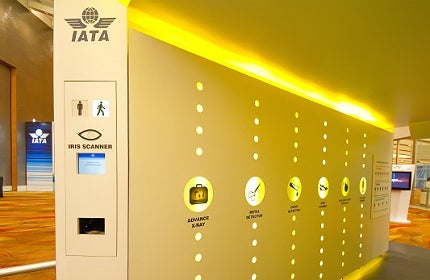

Discover B2B Marketing That Performs
Combine business intelligence and editorial excellence to reach engaged professionals across 36 leading media platforms.
Today’s airport security checkpoints are a reflection of the turbulent times in which we live. Since the seismic shift provoked by the September 11 attacks, the airport security emphasis for governments and the aviation industry has understandably skewed towards rigorous screening and a take-no-chances approach, often at the expense of efficiency and passenger satisfaction.
According to the International Air Transport Association (IATA), modern security checkpoints at airports are currently able to process an average of 149 passengers an hour per lane. This is less than half of the 350 passengers an hour that pre-9/11 security lanes were able to achieve.
Improving checkpoint efficiency
The rise in security standards and the drop in checkpoint efficiency are causing an increasing number of operational problems for congested airports, and with international passenger growth expected to continue, the problem is going to get worse without intervention.
In IATA’s 2012 Global Passenger Survey, passengers revealed that their three biggest airport security gripes are long queuing times (37%), being forced to remove shoes and belts (21%) and having to take electronic items out of bags (12%). These complaints, which are all focused on inconvenience and inefficiency, outstripped other privacy-based concerns, such as full body scanning and security pat-downs, which have traditionally attracted more attention from global media.

US Tariffs are shifting - will you react or anticipate?
Don’t let policy changes catch you off guard. Stay proactive with real-time data and expert analysis.
By GlobalDataWhile there is no doubt that a meticulous and comprehensive security process is still absolutely necessary, and will be for the foreseeable future, IATA and the industry are now working to improve the passenger experience at checkpoints while maintaining all-important security standards.
The Checkpoint of the Future
Back in June 2011, IATA unveiled the ‘Checkpoint of the Future’ (CoF) concept at its Annual General Meeting in Singapore. The association’s new concept emphasised a risk-based approach to airport security, integrating passenger information into the screening process.
Under the new system, biometric information stored on passengers’ passports would be used to direct travellers to one of three lanes: a ‘known traveller’ lane for passengers who have registered and pre-completed background checks with government agencies; a ‘normal screening’ lane for the majority of travellers; and an ‘enhanced security lane’ for those with less available information or who are considered to present an ‘elevated risk’.
The system has been designed to address the efficiency complaints of passengers by allowing them to share basic information with the relevant authorities, in exchange for a faster screening process. According to IATA, its checkpoint concept would also do away with the need for passengers to remove items of clothing, as well as the need to take electronics and liquids out of hand luggage.
"CoF will replace today’s one-size-fits-all approach to screening with a model based on risk assessment," said IATA director general and CEO Tony Tyler in October 2012. "By focusing resources where the need is greatest we will make the system more secure and reduce the hassle for our customers."
Despite its obvious advantages to everyday passengers, a potential stumbling block for the new system is public concern about privacy and passenger profiling, which would realistically form a central part of any biometrics-led security process.
As CoF approaches implementation in major airports, it’s inevitable that there will be some controversy about unfair targeting of passengers, but IATA believes that the majority of airport users are willing to trade some personal information for a quicker and more convenient security system. The organisation’s passenger survey backs up this belief, with nearly three-quarters of surveyed airport users expressing a willingness to share information if it will expedite airport screening. Support was especially strong among frequent flyers and business travellers.
Still, with the use of personal information coming to the forefront, there will undoubtedly be concerns about data security and the possibility for terrorists to abuse the known traveller system that need to be addressed.
Testing and implementation: roadmap to CoF adoption
IATA has shown off a mock-up of what the three-lane security system might look like, but the real test for the viability of CoF will be all the biometric, remote camera and screening technologies that will comprise the wider system. Creating an international web of passenger information, which is reliable enough to form the backbone of a new airport security paradigm, is a serious task after all.
With that in mind, IATA spent 2012 working with several major airports to trial specific components of the system. At Geneva Airport in Switzerland, the project installed a prototype biometric identification system to trial the use of e-passport information transfer and ID verification using an infrared camera.
The trials then moved on to London Heathrow Airport, where a remote camera system was tested to demonstrate that the process could pass information from one camera to the next for verification. Finally, a screening technology trial was conducted at Amsterdam Schiphol to test equipment that would allow passengers to leave electronics and liquids in their carry-on bags.

High-tech: IATA’s checkpoint concept
In 2013, IATA plans to carry out around a dozen further component trials, leading to the planned unveiling of a complete CoF system in 2014. Although the technology to make this new system possible will likely be ready within the next two years, the organisational push required to implement a biometric security approach leaves the programme with a significant hill to climb.
As a result, the CoF adoption plan stresses a phased implementation. In 2014, IATA expects to see the emergence of individual ‘known traveller’ programmes, along with a move towards risk assessment-based security and differentiated screening at major airports. These immediate steps are intended to lead to more significant advances in international known traveller schemes, government data assessment capabilities, ID authentication and automated behavioural technologies by 2017. By this time, IATA also projects that airports will begin to eliminate the need for passengers to remove belts and shoes.
IATA’s final milestone is 2020, by which time the association expects that differentiated, data-driven screening will be commonplace around the world, with passengers able to move uninterrupted through security, unless the system flags up a potential threat. So the countdown to the Checkpoint of the Future starts here; in the meantime, airports, government agencies and IATA have a lot of work left to do.
Related content
Video feature: Concourse A: Dubai Airport’s world first A380 facility
This year Dubai International Airport will advance on its bid to be the world’s leading aviation hub by phasing in its new, world first A380 facility.
Air traffic control: an easy target for hackers?
Next-generation ADS-B aircraft tracking systems are set to revolutionise future ATC operations, but are the signals adequately protected from hacking?






